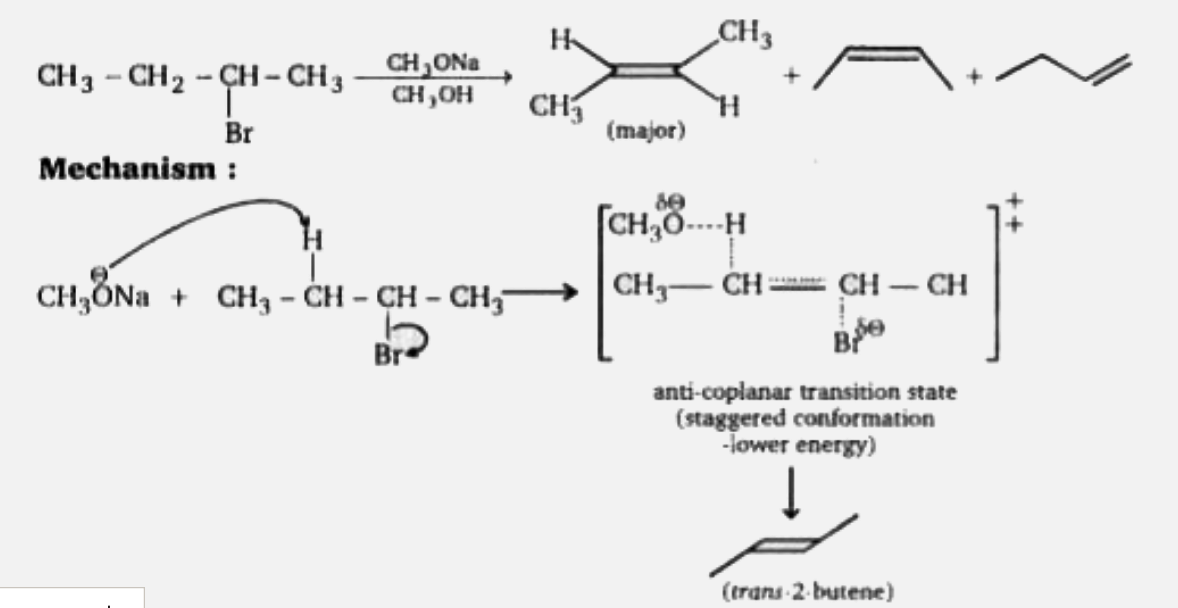Relative rate of reaction with .
 Solution in Kannada
Solution in Kannada
The correct Answer is:C
Consider NGP more nucleophilic alkene will have more rate ofreaction
Topper's Solved these Questions
- ALKYL HALIDES (SUBSTITUTION REACTIONS)BOOK - MS CHOUHANCHAPTER - ALKYL HALIDES (SUBSTITUTION REACTIONS)EXERCISE - LEVEL-2
41 Videos
- ALKYL HALIDES (ELIMINATION REACTION) BOOK - MS CHOUHANCHAPTER - ALKYL HALIDES (ELIMINATION REACTION) EXERCISE - LEVEL-2
25 Videos
- AMINESBOOK - MS CHOUHANCHAPTER - AMINESEXERCISE - Level-2
1 Videos
Similar Questions
Statement - 1 : Nucleophilicity order in polar-protic solvent is I−<Br−<Cl−<F−
Statement-2 : Due to bigger size of I it is less solvated in polar-protic solvent.
View SolutionComprehension
E2 raction → Elimination bimolecular
In the general mechanism of the E2 reaction a strong base abstract a proton on a carbon atom adjacent to the one of the leaving group. As the abstracts a proton , a double bond forms and the leaving group leaves.

Identify the rate of reaction of given compounds in E2 reaction:

View SolutionFive amine syntheses are outlined below. In each reaction box enter a single letter designating the best reagent and conditions selected from the list at the bottom of the page.


View SolutionFor the reaction 2H_(2)+O_(2)rarr 2H_(2)O , the rate law expression is , r = k[H_(2)]^(n) . When the concentration of H_(2) is doubled, the rate of reaction found to be quadrupled. The value of n is
View SolutionThe relative rates of reaction with concentrated H2SO4 of the following is
(I)
(II)
(III)
View SolutionIn the reaction
[A(H2O)6]3++H2O⇔[Al(H2O)5OH]2++H3O+
View SolutionIn the reaction HCl + H_(2)O hArr H_(3)O^(+) + Cl^(-)
View SolutionRelative rate of methyl bromide in SN^(2) reaction is
View SolutionC––O+H2O→No reaction
View SolutionN––O+H2O→No reaction
View SolutionFor a reaction : A+H_(2)O toB," Rate "propA"]". What is its (i) Molecularity (ii) Order of reaction ?
View SolutionConsider this reaction,
2H2(g)+2NO(g)→N2(g)+2H2O(g)
The rate law for this for reaction is rate =k[H2][NO]2 .
Under what conditions could these Steps represent the mechanism?
Step1: 2NO→N2O2
Step2: N2O2+H2→N2O+H2O
Step3:N2O+H2→N2+H2O
View SolutionExplain why the reactions of D2 O occur at a rate slower that the corresponding reactions of H2O.
View SolutionIn the reaction HCl + H_(2)O to H_(3)^(+)O +Cl^(-)
View SolutionC––O+H2O→No reaction
View Solutionअमोनिया के दहन से NO तथा H2O बनता है । 4NH3(g)+5O2(g)→4NO(g)+6H2O(g)
इस समीकरण के लिए सापेक्षिक अभिक्रिया दर लिखे ।
View Solution
